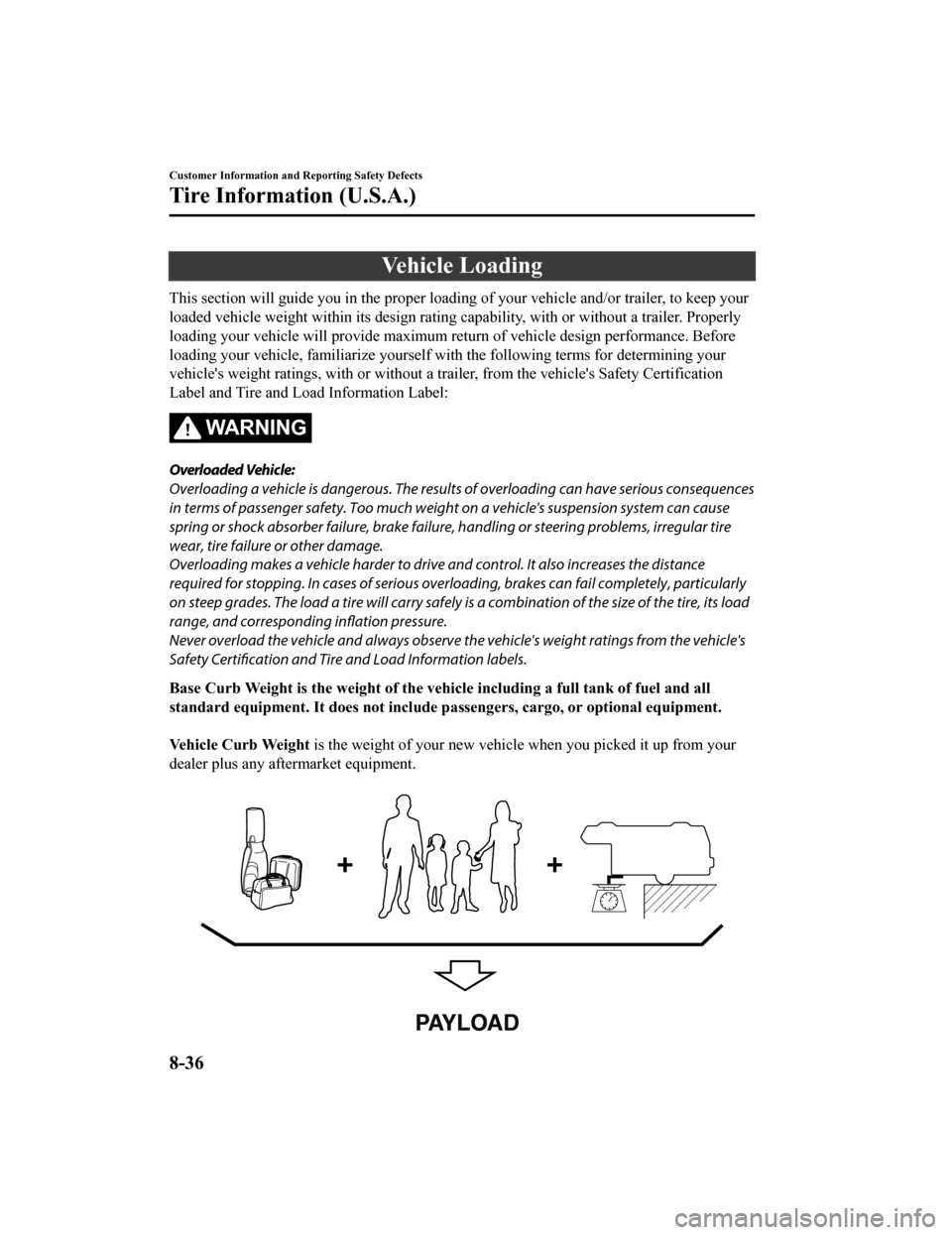tire size MAZDA MODEL CX-9 2020 (in English) Owner's Manual
[x] Cancel search | Manufacturer: MAZDA, Model Year: 2020, Model line: MODEL CX-9, Model: MAZDA MODEL CX-9 2020Pages: 706
Page 661 of 706

WA R N I N G
Always check the tire inflation pressures on a regular basis according to the recommended
tire inflation pressure on the tire label and in conjunction with the information in this owner's
manual:
Driving your vehicle with under-inflated tires is dangerous.
Under-inflation is the most common cause of failures in any kind of tire and may result in
severe cracking, tread separation or “blowout”, with unexpected loss of vehicle control and
increased risk of injury. Under-inflation inc reases sidewall flexing and rolling resistance,
resulting in heat buildup and internal damage to the tire. It results in unnecessary tire stress,
irregular wear, loss of control and accidents. A ti re can lose up to half of its air pressure and
not appear to be flat!
It is impossible to determine whether or not tires are properly inflated just by looking at them.
▼Checking Tire Pressure
1. When you check the air pressure, make sure the tires are cold
―meaning they are not
hot from driving even a mile.
2. Remove the cap from the valve on one tire.
3. Firmly press a tire gauge onto the valve.
4. Add air to achieve recommended air pressure.
5. If you overfill the tire, release air by push ing on the metal stem in the center of the
valve. Then recheck the pressure with your tire gauge.
6. Replace the valve cap.
7. Repeat with each tire, including the spare.
NOTE
Some spare tires require higher inflation pressure.
8. Visually inspect the tires to make sure there are no nails or other objects embedded that
could poke a hole in the tire and cause an air leak.
9. Check the sidewalls to make sure there are no gouges, cuts, bulges, cracks or other irregularities.
▼Glossary of Terms
Tire Placard:
A label indicating the OE tire sizes, recommended inflation pressure, and the
maximum weight the vehicle can carry.
Tire Identificatio n Number (TIN): A number on the sidewall of each tire providing
information about the tire brand and manufacturi ng plant, tire size, and date of manufacture.
Inflation Pressure: A measure of the amount of air in a tire.
kPa: Kilopascal, the metric unit for air pressure.
psi: Pounds per square inch, the English unit for air pressure.
B-pillar: The structural member at the side of the vehicle behind the front door.
Customer Information and Reporting Safety Defects
Tire Information (U.S.A.)
8-31
CX-9_8HT8-EA-19I_Edition2_old 2019-9-24 13:14:55
Page 666 of 706

Ve h i c l e L o a d i n g
This section will guide you in the proper loading of your vehicle and/or trailer, to keep your
loaded vehicle weight within it s design rating capability, with or without a trailer. Properly
loading your vehicle will provide maximum return of vehicle design performance. Before
loading your vehicle, familiarize yourself with the following terms for determining your
vehicle's weight ratings, with or without a trailer, from the vehicle's Safety Certification
Label and Tire and Load Information Label:
WA R N I N G
Overloaded Vehicle:
Overloading a vehicle is dangerous. The results of overloading can have serious consequences
in terms of passenger safety. Too much weight on a vehicle's suspension system can cause
spring or shock absorber failure, brake failu re, handling or steering problems, irregular tire
wear, tire failure or other damage.
Overloading makes a vehicle harder to drive an d control. It also increases the distance
required for stopping. In cases of serious overloading, brakes can fail completely, particularly
on steep grades. The load a tire will carry safely is a combination of the size of the tire, its load
range, and corresponding inflation pressure.
Never overload the vehicle and always observe th e vehicle's weight ratings from the vehicle's
Safety Certification and Tire and Load Information labels.
Base Curb Weight is the weight of the ve hicle including a full tank of fuel and all
standard equipment. It does not include passengers, carg o, or optional equipment.
Vehicle Curb Weight is the weight of your new vehicl e when you picked it up from your
dealer plus any aftermarket equipment.
PAYLOAD
Customer Information and Reporting Safety Defects
Tire Information (U.S.A.)
8-36
CX-9_8HT8-EA-19I_Edition2_old 2019-9-24 13:14:55
Page 687 of 706

Interior light
Light bulbCategory
Wattage UN-R*1
Overhead lights (Front)/Map lights
(Front) LED type
LED*2―
Bulb type 8 ―
Overhead lights (Center)/Map lights
(Center) LED type
LED
*2―
Bulb type 8 ―
Overhead light (Rear) LED type
LED
*2―
Bulb type 10―
Ambient lights
*LED*2―
Vanity mirror lights
*LED type LED*2―
Bulb type 2―
Luggage compartment light LED type
LED
*2―
Bulb type 8 ―
*1 UN-R stands for United Nations Regulation.*2 LED is the abbreviation for Light Emitting Diode.
▼Tires
NOTE
The tires have been optimally matched with the chassis of your vehicle.
When replacing tires, Mazda recommends that you replace tires of the same type originally
fitted to your vehicle. For details, contact an Authorized Mazda Dealer.
Check the tire pressure label for tire size and inflation pressure.
Refer to Tire Inflation Pressure on page 6-38.
Standard tire
(U.S.A. and Canada)
Tire size Inflation pressure
Front Rear
P255/60R18 107H 230 kPa (34 psi)230 kPa (34 psi)
P255/50R20 104V 230 kPa (34 psi)230 kPa (34 psi)
(Mexico)
Tire size Inflation pressure
Front Rear
P255/50R20 104V 230 kPa (2.3 bar, 33 psi) 230 kPa (2.3 bar, 33 psi)
Specifications
Specifications
*Some models.9-7
CX-9_8HT8-EA-19I_Edition2_old 2019-9-24 13:14:55
Page 688 of 706

Temporary spare tire
(U.S.A. and Canada)
Tire sizeInflation pressure
T155/90D17 101M 420 kPa (60 psi)
(Mexico)
Tire sizeInflation pressure
185/80R17 99M 320 kPa (3.2 bar, 46 psi)
Lug nut tightening torque
When installing a tire, tighten the lug nut to the following torque.
108―147 N·m (12―14 kgf·m, 80 ―108 ft·lbf)
▼Fuses
Refer to Fuses on page 6-50.
Specifications
Specifications
9-8
CX-9_8HT8-EA-19I_Edition2_old
2019-9-24 13:14:55